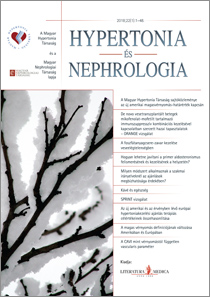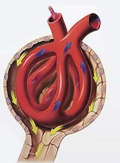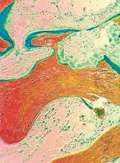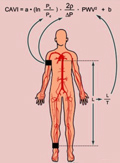The eLitMed.hu medical portal uses computer cookies for convenient operation. Detailed information can be found in the Cookie-policy.
Hypertension and nephrology - 2018;22(01)
Content
[Experience with mycophenolate mofetil containing immunosuppressive regimen in de novo kidney transplant recipients (ORANGE study).]
[Mycophenolate mofetil (MMF) has been used as an immunosuppressive agent in renal transplant recipients for more than two decades. The aim of the ORANGE study was to collect data with respect to the efficacy and safety of MMF containing immunosuppressive regimens during standard nephrology care in Hungarian clinical centres. Efficacy of the therapy was primarily evaluated via moni - toring of renal function based on glomerular filtration rate (GFR) values calculated on the basis of the MDRD-175 formula. A total number of 128 patients were en rolled in two clinical centres within the frames of an open-label, non-interventional study. During the course of the study, mean GFR values showed stable renal function between the 1st month (53.5±33.4 ml/min/1,73 m2) and the 12th month (58±16.3 ml/min/1,73 m2). Acute graft rejection occurred in 21 patients during the first month, further, 1-1 rejection was documented in the remaining period between 2-6 and 6-12 months after renal transplantation, respectively. The graft survival was 100% 1 month after renal transplantation, while this ratio was calculated to be 98.4% after 12 months.]
[Therapy of pathological phosphate metabolism in chronic kidney disease]
[The Kidney Disease Improving Global Outcomes (KDIGO) clinical practice guideline update for Chronic Kidney Disease Mineral and Bone Disorder (CKD-MBD) was published in the summer of 2017 and has become a very important guidance of the complex therapy of patients with CKD. It is well known that, besides infections, cardiovascular diseases in close causal relationship with CKD-MBD are leading mortality factors of patients with CKD. Therefore the publication of the new international guideline is especially important. A Nationwide Professional Advisory Board summoned upon the initiative of the Hungarian team of Sanofi-Aventis had its assembly in September 2017 focusing on the current approaches of the therapy of calcium-phosphate metabolism in CKD patients in Hungary. Board members compared the differences between the 2009 and 2017 KDIGO guidelines and reviewed the 2011 Hungarian CKD-MBD recommendation and the relevant financing protocol. Board members assessed the applicability of the new guideline to current Hungarian practice. As compared to the previous 2009 guideline, although a number of issues were revised and modified in the light of new research and clinical results in the new 2017 guideline, most of the recommendations are still applicable tooure very day practice. It is a fundamental requirement to keep to the new guideline including the modified recommendations to optimize the long term life expectancy and quality of life of patients with CKD. The purpose of this article is to compare the 2009 and 2017 KDIGO guidelines in terms of calcium-phosphate metabolism and the treatment of hyperphosphataemia focusing on the new or modified guideline recommendations in order to assess the feasibility of their implementation in Hungarian practice. Based on available evidence and the new KDIGO guideline, board member sout lined the direction of changes of the Hungarian CKD-MBD protocol and the prescription rules of the related medications.]
[How the recognition and treatment of primary aldosteronism could be improved?]
[Practically there were no randomized, controlled trials in the area of PA so far, but recently two such ones have appeared. In addition, both are paradigm- forming; yet not built into (yet?) the expert opinions. In the field of primary aldosteronism (PA), there is a sharp contrast between the world’s leading experts in many areas. There is consensus in respect that hypokalaemia, therapy resistance and vascular complications are more common in PA than in primary hypertension. According to prestigious studies, the ratio of surgically correctable cases can be around 5% of hypertension. However, only a tiny fraction of these cases are ever investigated even in the developed countries. Specific treatment might be reached more easily by a multi-speed approach applicable for domestic conditions in which one of the alternatives is the diagnostic process itself. In the latter, following aldosterone criteria are proposed: at screening greater than 15 ng/dl when associated with low renin, in the suppression test, for further testing (adrenal CT) a concentration above 5 ng/dl. This would provide a sufficient balance between sensitivity and specificity. Another solution could be the more widespread use of low dose spironolactone in resistant hypertension.]
1.
Clinical Neuroscience
Is there any difference in mortality rates of atrial fibrillation detected before or after ischemic stroke?2.
Clinical Neuroscience
Factors influencing the level of stigma in Parkinson’s disease in western Turkey3.
Clinical Neuroscience
Neuropathic pain and mood disorders in earthquake survivors with peripheral nerve injuries4.
Journal of Nursing Theory and Practice
[Correlations of Sarcopenia, Frailty, Falls and Social Isolation – A Literature Review in the Light of Swedish Statistics]5.
Clinical Neuroscience
[Comparison of pain intensity measurements among patients with low-back pain]1.
Clinical Neuroscience Proceedings
[A Magyar Stroke Társaság XVIII. Kongresszusa és a Magyar Neuroszonológiai Társaság XV. Konferenciája. Absztraktfüzet]2.
3.
Journal of Nursing Theory and Practice
[A selection of the entries submitted to the literary contest "Honorable mission: the joys and challenges of our profession" ]4.
Journal of Nursing Theory and Practice
[End of Life and Palliative Care of Newborns in the Nursing Context]5.
Journal of Nursing Theory and Practice
[Aspects of Occupational Health Nursing for Incurable Patients ]






